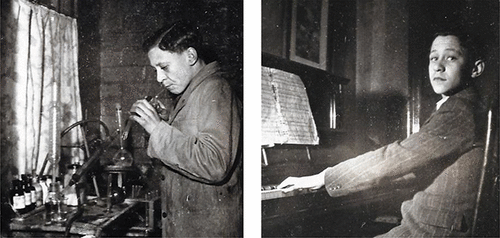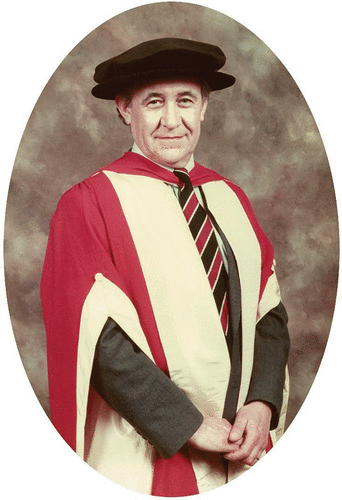
Professor Harry Robinson Hudson
(18th November 1929–20th April 2016)
Emeritus Professor, London Metropolitan University
Harry R. Hudson, to whom this journal's present issue is dedicated, died on April 20, 2016, aged 86.
Harry was known for many years for his complete dedication to science, and, in particular, for his work in organophosphorus, in which he inspired a huge number of undergraduate and postgraduate students and UK and international collaborators. He was also a dedicated teacher of organic chemistry to a wide range of students.
Born in Kingston-Upon-Hull, Harry was evacuated to Glossop, Derbyshire, to the home of a cousin, Frank Hudson, to avoid the major bombing that the city suffered. During this time, it could be said that Harry began his long interest in chemistry. Explosives were not difficult to find and Harry, with cousin Frank, prepared and detonated an assortment of explosives in the garden much to the consternation of the neighbors! Harry was dedicated to music, and learned to play the violin and piano in his early years.
Harry Hudson aged 17 carrying out an experiment in the kitchen of his home (left), and playing the piano (right).

Harry attended Riley High School for Boys in Hull and subsequently he obtained his BSc Hons in Chemistry as an external student of the University of London while studying at Hull Municipal Technical College (later to be Humberside Polytechnic/University, the Chemistry part of which eventually moved into the University of Hull). Following 2 years national service in the RAF Education Branch and 7 years as a research and development chemist at Distillers Company in Hull, Harry was appointed in 1958 as a research assistant at the Northern Polytechnic and, as the Northern Polytechnic Report on the Work of the Session (1960–1961) notes, he was “appointed to the services of the Governors' as a lecturer on 1st December 1960 in the Department of Chemistry, Mathematics, Botany, Zoology, Biology, and Geology.” He continued at the Polytechnic as it became the Polytechnic of North London, then University of North London, and finally London Metropolitan University.
By 1960, Harry completed a PhD under the direction of the Head of Department, Dr. William Gerrard. It is worth noting that Harry's contemporaries at the time included chemists who would become heads of at least four departments of chemistry (one of whom also became President of the Royal Society of Chemistry), two who became vice chancellors, and one was the head of the Council for National Academic Awards, the body that awarded degrees on behalf of the polytechnic sector. Were it not for Harry's total commitment to his teaching and research, there is no doubt he would have achieved similar roles.
Harry was a recognized teacher of the University of London from 1965, a member for many years of the University of London's Board of Studies in Chemistry and the Chemical Industry, and its boards of staff examiners for BSc Chemistry and BSc general degrees for internal and external students. He also acted as an assistant examiner for London GCE “A” level Chemistry for over 20 years.
Harry's career achievements can best be understood by just a few of the tributes sent by ex-students/colleagues after his demise.
He always encouraged and never belittled, which was quite a feat, given his vast experience and standing.
I have learned a great deal from Harry in the last 23 years and will never forget his smile and enthusiasm.
Harry was an exceptional organophosphorus chemist, especially in the field of organophosphorus esters. We have long collaborated, and will continue with his spiritual presence.
He was more than a professor to me. He was my guardian and my mentor. After my departure from the UK, he still continued to show a keen interest in my academic progress. Today my status as full professor of organic chemistry … can be attributable to the role he played in my life.
I want to express my recognition of the importance of Professor Hudson to my PhD during 1983 and 1987 when I had the honor to have the dear professor as supervisor of my thesis.
I remember Professor Hudson from the 1970s. He was one of the major figures in organophosphorus chemistry in Europe and visited our center in Lodz. At the time he gave us a breath of world chemistry and research behind the curtain.
While there were serious collaborations with a country in the Soviet bloc, they were always convivial, and I greatly enjoyed Harry's company in the social period we spent together.
He was so hard working and yet still fun!
Watching Harry in action with his research students he was always the “teacher and guide” as well as supervisor. He would spend as much time as was necessary whatever the time of day to help a student. Maybe this is unsurprising when one notes that the first reference to Harry's activities in the Northern Polytechnic Report on the Work of the Session (1960–1961) states that “Dr H R Hudson is assisting in the supervision of postgraduate students engaged on [studies of optically pure alkyl halides] which have industrial as well as fundamental significance.” The same report describes no fewer than five research papers bearing Harry's name published in Chemistry & Industry, Journal of Chemical Society, Proceedings of Chemical Society, and Spectrochimica Acta. From then on, further annual reports always mentioned one or more of his publications.
Harry's output was phenomenal, publishing over 130 papers. He supervised over 40 research students from around the world, published sufficient papers, in numbers and quality, to be one of very few Polytechnic staff to be awarded a DSc (of the University of London in Harry's case). He was one of the first three members of the Polytechnic's staff to be promoted to a Readership, and one of the first group of six staff to be given a Professorial title by the University of North London. He was made Emeritus Professor in 1996.
Harry also had a commitment to the profession of chemistry and was a keen member of the Royal Society of Chemistry. He was a student member of The Royal Institute of Chemistry of Great Britain and Ireland in 1946. In 1950 he became an Associate of The Royal Institute of Chemistry (ARIC), and then a Fellow (FRIC, later to be converted to FRSC–Fellow of the Royal Society of Chemistry) in 1964. He was made a life member of the Royal Society of Chemistry in 1995.
I recall one occasion when Harry's passion for teaching and research (and his disdain for unnecessary bureaucracy) came to the fore. As head of the Chemistry Department I had to convene a staff meeting to discuss the institutional organizational changes taking place. This included such decisions as the creation of an academic board with over 90 appointed and elected members, boards of study for each major discipline area, and a plethora of other committees and working groups. Harry was quiet for a long period of time and finally, as his face became more and more flushed, he sprang into action. His passioned but carefully thought out contribution set out several arguments against much of what was being imposed in the name of “progress,” ending with the statement that he would do everything he could to avoid becoming involved in all this bureaucracy because as he put it: “All I want is to be left alone to do my teaching.” Of course, he meant his teaching and research.
I am probably one of very few people who ever supervised Harry's research, although “supervised” might be something of an exaggeration. This was during the time when he was producing various potentially commercial compounds. The efficacy of a particular compound (or, perhaps to be correct, a mixture of related compounds) had already been established and it was necessary to produce a radiochemically labeled version to find out how it might be metabolized by cows. I was the departmental radiochemist and radiological safety officer and had to ensure that Harry was fully versed in all the necessary handling and safety procedures. Perhaps, because of the very real risks, Harry was a very attentive student!
The preparation required the purchase of what was almost certainly the largest single quantity of radioactivity we had ever ordered. Furthermore, the preparation had to be carried out at high pressure in an autoclave. We had a number of discussions about what might happen if the autoclave seal were to burst. The minimum problem would have been that the Radiochemistry Laboratory would have been so contaminated that its fumed cupboards, walls, floor, and ceiling would have had to be completely removed by specialist contractors and replaced. The worst case was that the windows of the laboratory, based on the 12th floor of the Tower Block housing the laboratory, would blow out and a significant amount of radioactive material would spread across Holloway Road, one of the busiest urban roads in Western Europe.
Harry worked late day after day during the summer, first working through non-radioactive test runs and then using the radioactive material. Due to the life cycles of the cows there was an absolute cut-off date by which the material had to be ready for testing. The preparation went well but was only finished the night before the deadline. I well remember arriving at the laboratory at around 6 am the following day in order to transport the material in my old car to Musselburgh in Scotland, a distance of over 400 miles, where a consultancy company was to carry out the testing. It was only after setting off that I began to (a) realize that I could hardly stop for any reason and leave my car plastered with signs warning of radioactive materials, and (b) wonder whom I should call if my car broke down.
As has been mentioned in an obituary published by the Royal Society of Chemistry, Harry continued his research throughout his retirement. Just before he went into hospital he sent samples to Hungary for additional analysis, and just three weeks before he died, this collaborative work was published online in Phosphorus, Sulfur, and Silicon and the Related Elements and would also appear in print shortly.
Harry was a family man and enjoyed music and caravanning holidays with his children. He is survived by Jacky, his wife of 56 years, his children, Ruth, Mark, Sarah, and Daniel, and two grandchildren, Amy and Tom. He is remembered with affection by all who knew him.

